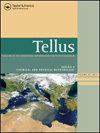Food web complexity enhances community stability and climate regulation in a geophysiological model
IF 2.3
4区 地球科学
Q3 METEOROLOGY & ATMOSPHERIC SCIENCES
Tellus Series B-Chemical and Physical Meteorology
Pub Date : 1999-09-01
DOI:10.3402/TELLUSB.V51I4.16489
引用次数: 20
Abstract
A central debate in community ecology concerns the relationship between the complexity of communities and their stability. How does the richness of food web structures affect their resistance and resilience to perturbation? Most mathematical models of communities have shown that stability declines as complexity increases but so far, modellers have not included the material environment in their calculations. Here an otherwise conventional community ecology model is described, which includes feedback between the biota and their climate. This “geophysiological” model is stable in the sense that it resists perturbation. The more complex the community included in the model, the greater its stability in terms of both resistance to perturbation and rate of response to perturbation. This is a realistic way to model the naturalworld because organisms cannot avoid feedback to and from their material environment. DOI: 10.1034/j.1600-0889.1999.t01-3-00006.x在地球生理模型中,食物网的复杂性增强了群落稳定性和气候调节
群落生态学的一个核心争论是关于群落的复杂性和稳定性之间的关系。食物网结构的丰富性如何影响它们对扰动的抵抗力和恢复力?大多数关于群落的数学模型表明,稳定性随着复杂性的增加而下降,但到目前为止,建模者还没有将物质环境纳入他们的计算中。这里描述了一个传统的群落生态学模型,它包括生物群和气候之间的反馈。这个“地球生理学”模型是稳定的,因为它能抵抗扰动。模型中包含的群落越复杂,其对扰动的抵抗力和对扰动的响应率就越稳定。这是一种模拟自然世界的现实方法,因为生物体无法避免来自其物质环境的反馈。DOI: 10.1034 / j.1600 0889.1999.t01 - 3 - 00006. x
本文章由计算机程序翻译,如有差异,请以英文原文为准。
求助全文
约1分钟内获得全文
求助全文
来源期刊
自引率
0.00%
发文量
3
期刊介绍:
Tellus B: Chemical and Physical Meteorology along with its sister journal Tellus A: Dynamic Meteorology and Oceanography, are the international, peer-reviewed journals of the International Meteorological Institute in Stockholm, an independent non-for-profit body integrated into the Department of Meteorology at the Faculty of Sciences of Stockholm University, Sweden. Aiming to promote the exchange of knowledge about meteorology from across a range of scientific sub-disciplines, the two journals serve an international community of researchers, policy makers, managers, media and the general public.

 求助内容:
求助内容: 应助结果提醒方式:
应助结果提醒方式:


